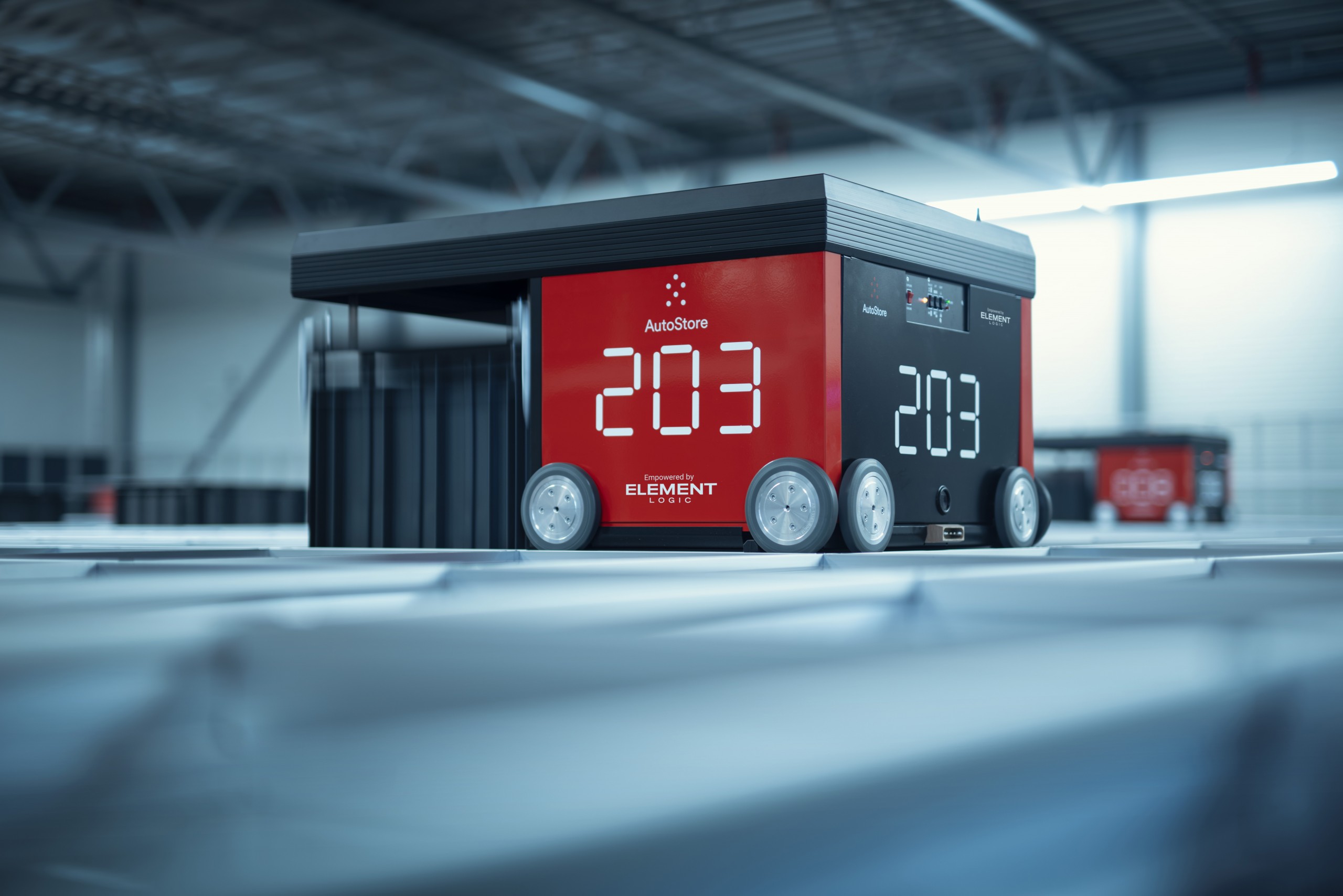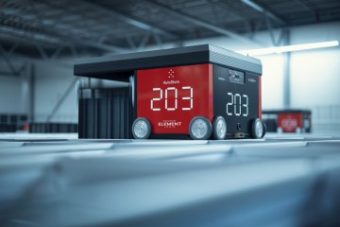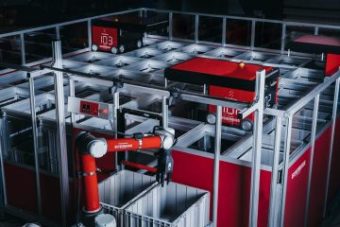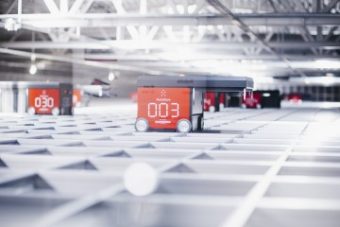What is AutoStore? Our guide to AutoStore
Many businesses are already using an AutoStore warehouse automation solution to increase storage capacity, improve cost-efficiency, reduce reliance on manual labour, and bolster the overall customer experience. If you have similar needs and want to know how AutoStore automation will benefit your business, this guide will answer your questions.

So, what is AutoStore?
AutoStore is an innovative goods-to-person automated storage and retrieval system (ASRS) that offers the market’s fastest order fulfilment solution per square metre. With the highest density of any ASRS, AutoStore is a cube-based storage system with its design roots in the Rubik’s Cube concept.
The system gives customers the speed, precision, and reliability they need in today’s fast-paced, omnichannel economy. AutoStore technology is also eco-friendly and energy-efficient, with a dependable average system uptime of 99.7% and the ability to support 24/7 operations.
Get in touch with our experts today and learn more about AutoStore
How does AutoStore work?
Rather than using traditional shelving to store products in a warehouse, which wastes space due to the requirement of walkways and aisles between shelves, AutoStore’s design improves storage capacity and density. Bins containing products are stacked directly on top of and next to each other in a condensed, space-efficient grid-style system.
Order-picking robots travel on the system’s top layer to retrieve the bins, making it possible to build the grid around columns, on mezzanines, and on top of floors with varied elevations. Therefore, this flexible and modular robotics solution typically increases warehouse floor space utilisation by 400% compared to static shelving. It can be adapted or scaled as space requirements increase to maximise efficiency, while AutoStore’s innovative order fulfilment capabilities also accommodate your company’s growth.
The AutoStore system design allows for growth in line with your specific business needs – each attribute of an AutoStore can be adapted independently from the others. It’s possible to add more robots or ports if you require more throughput due to growth in demand. If you have launched a new product range and need more storage, you can extend the grid and add the required bins into the system. All of these can take place while the rest of the system remains operational.
Taking advantage of the Pareto principle
In general warehousing, conducting an ABC analysis of your products is obligatory. However, AutoStore takes advantage of what is known as the Pareto principle – where 80% of order lines are associated with 20% of stock-keeping units (SKUs), which is prevalent in eCommerce order profiles. So, AutoStore operates on the elementary rule that every time a bin is presented to a port and then returned to the grid, it always returns to a random top location. Therefore, bins containing popular or fast-moving SKUs will already be sitting at the top of the grid, ready for the next batch of consumer orders.
This also means that the system will reconfigure itself naturally when there is a change in the SKU profile, such as for fashion items. For example, jumpers and warm clothing make up the most ordered SKUs in winter, meaning they will be on top of the grid. As the weather changes and we move into warmer weather, customers may order sunglasses or sandals. When ordered for the first time after a period of inactivity, these items may need to be “dug” up as they have sunk down the grid to the bottom of a stack. This is what the Pareto principle dictates.
However, the moment these items are retrieved for that first order, the SKUs are placed back on top of the grid. Any subsequent orders will automatically come from the top of the grid now that the weather has changed, thereby avoiding a repeat of the initial preparation work.
Always a step ahead
One of the most important things to keep in mind is that the AutoStore warehouse robots are working ahead of the operators to prepare for the next wave of orders. A worst-case scenario could be that a required bin is located at the bottom of a stack of bins in the most far-flung corner of the grid from where the ports are. Retrieving the bin would take approximately three-and-a-half minutes – a lot less than walking to the most faraway shelf in a traditional warehouse. Yet, the retrieval activity happens roughly 30 minutes before the bin gets delivered to an operator for picking. Consequently, the operator at the port has absolutely no sense of the difference between a fast-moving product and a slow-moving one.
All of the above means that in normal ecommerce operations, 80% of the order lines that need to be picked will come from a bin located in the top two to three layers of the AutoStore grid. Only on rare occasions will robots have to dig to the bottom of a stack to retrieve slower-moving bins, thereby negating the need for the ABC analysis.
What makes up an AutoStore solution?
While you can customise each AutoStore solution to match unique operational needs, they all start with six basic components that easily integrate into any existing facility.
These are:
- Robots
- Grid
- Controller
- Ports
- Bins
- Software
Let’s look at each of these in more detail.
1. Delivery robots
The robots are the foot soldiers of the AutoStore system. They drive, dig, collect, and deliver bins to workstations incessantly and tirelessly. All models of AutoStore robots have eight wheels for five-directional movement. This way, they can reach any point in the grid to pick, transport and place bins. The robots pick and deliver goods in the smartest available routes on the grid as calculated by the controller. A fleet of robots can operate 24/7 and have smart charging criteria that allow them to take the opportunity to replenish their energy when activity on the grid is not at its busiest.
AutoStore offers the Red Line robot (R5 and R5+) and the Black Line robot, the B1. The Red Line robots are the workhorses of the fleet and the most established robot in the range, making up over 75% of the existing AutoStore systems globally.
The award-winning, fifth-generation Red Line robots use energy-efficient drives and a recuperation system, enabling them to operate with minimal interruption. When the battery is low or during downtime hours, they move to chargers located at the edge of the grid. These robots are still industry leaders after more than 20 years on the market.
The new, slimmed-down, lighter B1 robots run on lithium-ion batteries and direct drive wheels for special and dedicated applications. This robot has greater acceleration and top speed, allowing it to reach its destination quicker. Like the R5+ robot, it is built to handle the taller 425mm bin, but in the B1, the bin is transported within the cavity of the robot’s body to reduce its operational footprint on the grid. The slimmer body profile creates space for tighter and busier robot clusters. These robots require no fixed station for charging. Instead, the patented BattPack technology enables them to exchange batteries at the BattPack stations within 30 seconds at any time.
Whether the R5, the B1, or a combination, you can assemble a team of AutoStore warehouse robots tailor-made for your needs.
2. Structural grid
Optimised for cube-based storage, the AutoStore grid provides unparalleled storage density and product security. It’s made of lightweight aluminium profiles, making the grid flexible to design and easy to install. The size and shape of the grid are only restricted by the warehouse around it, ensuring optimal space usage.
The grid consists of columns that make up the cells inside the grid, with each cell containing multiple stacked bins. Topping off the grid are tracks running in X and Y directions so that the robots can access any cell.
3. AutoStore (AS) controller
The controller is the command centre of AutoStore and is responsible for two essential actions within the AutoStore grid:
- the location of every bin, robot, and port
- looking after the traffic management and route planning of every task executed by each robot
An important distinction is that the AutoStore controller has no idea what products are located within a single bin, how many units of that SKU are contained within the bin, or what activity is happening to a bin when the system presents it to a port. Instead, Element Logic’s eManager software platform manages and controls all this information.
4. Operator ports
These are the workstations where the AutoStore robots deliver the goods for operators to pick. All AutoStore ports can conduct any operation within the system, whether inbound or outbound order processing or inventory inspection tasks. The only difference between the various ports is what we refer to as the bin exchange time.
AutoStore provides five port modules to match the speed and size of any warehouse or fulfilment centre:
- Conveyor port: Being available in either narrow or wide-side handling allows it to be placed in any orientation or side of the AutoStore. The bin exchange time of the conveyor port is approximately 6-7 seconds. Therefore, the port is more common in operations where the time needed between picking one SKU and the second is longer than the 6-7 seconds, and the number of bins required to complete a single task group is generally quite low. It’s also quite commonly utilised for goods-in operations.
- Carousel port: Available in wide-side handling only, this port comprises a tri-armed high-speed bin exchange process, typically used in pick-and-pack (one-touch dispatch) operations. It’s larger than the conveyor port and features a built-in work surface that lends itself well to picking, packing, and dispatching orders at the port.
- Swing port: Swing ports are suitable where the AutoStore grid is located on a mezzanine floor, and the goods are required at ground floor level. The port utilises an internal bin lift to allow robots to retrieve a bin. The depth at which the port can be placed below the AutoStore grid is adjustable.
- Relay port: This is the fastest AutoStore port module, typically used in high-speed pick-and-pass operations. Multiple robots deliver to central cells, creating a rapid flow of bins to the operator.
- Pick-up port: A newly introduced public-facing port that allows shoppers to quickly pick up their online purchases with the help of AutoStore robots.
5. Storage bins
Measuring 400mm x 600mm on the inside, the bins are the inventory containers of AutoStore. The bins, which can be divided into different-sized compartments with inserts, come in three height options to fit your storage needs: 220mm, 330mm, and 425mm. The tallest is compatible with B1 and R5+.
Unique construction and gentle robot handling make the bins extremely durable and able to withstand many movements over years of service. The world’s first AutoStore warehouse in Norway still uses the bins it installed in 2005.
The bins comprise a stiff top frame with guiding details, a rigid bottom design, four openings for the robot gripper hooks, and ribs designed for stability and top loads. The bin load is up to 30kg. Each bin has a unique ID stored in the AutoStore Controller database matched to a label on the bin, giving it complete control over the contents of each bin at any given time. This allows the controller to know the whereabouts of any bin in the system.
6. Software
Although not obligatory with AutoStore use, eManager is Element Logic’s propriety software specifically developed to maximise automated warehouse efficiency with AutoStore.
Designed from the outset to be the perfect partner to AutoStore, eManager dynamically interfaces with your ERP or WMS, receives all your inbound and outbound transactions to and from the AutoStore system, and optimises the workload. It creates specific tasks for AutoStore to execute, making sure you can provide seamless order fulfilment, regardless of operational challenges.
With eManager, you constantly have product location and inventory control. Tried-and-tested modules take care of the most common industry activities, such as picking and put-away, including bespoke modules suited to your specific operation.
What makes Element Logic’s AutoStore software even more versatile is that it’s possible to fully integrate it with your existing WMS or enterprise resource planning (ERP) system. It offers a black box solution where the ERP or WMS is in one location and from where eManager manages inbound and outbound lists received from these systems. The software also performs inventory control at the product or batch level and sends the updated balance to the ERP or WMS.
It’s the portal to all the information you need to optimise your operations and prepare for growth. With its user-friendly interface and built-in AutoStore assistance, your employees will receive thorough training on optimised usage.
Who can use AutoStore automation?
AutoStore is for any company that wants to take its operations to the next level by eliminating excess processes via automation. It’s also a perfect fit if your business needs more storage space. But instead of paying for new warehouse space, you can use your existing space intelligently to condense your product footprint.
AutoStore’s high-density design allows you to reduce your overall warehouse footprint by up to 75%. The system is particularly suitable for ecommerce, retail, healthcare, grocery, and small electronics companies. AutoStore is also ideal for third-party logistics (3PL) companies and companies with micro fulfilment centres.
How much does AutoStore cost?
The total cost of an AutoStore investment depends on several factors.
The system investment and annual costs, such as software license fees, service and maintenance, and support, must be offset against potential manpower, floor space, and energy savings.
What are the benefits of AutoStore?
AutoStore automation provides the competitive edge to manage inventory and meet next-day or same-day delivery promises in today’s hyper-fast environment.
Not only is it a cost-effective investment, but it also offers the following benefits:
- Easy to get started: All AutoStore systems comprise the same six basic components, all designed from the ground up and tailored specifically for each customer. The software deployed on the system is versatile and easy to work with, capable of integrating with most WMS or ERPs worldwide.
- Improved control infrastructure: The system software is cloud-based, so there’s no need to be concerned that component failure will shut down your entire operation. You can access your most critical information from your browser.
- No need for excessive automation: Many automation solutions require extra modules that exist purely to join the critical components of a system that add value together. Conversely, AutoStore is a complete package with simple, intelligently designed, and multifaceted modules, making the system a “multitool” piece of automation.
- No more complex conveyor systems: Products no longer need to pass from hand to hand or travel around the warehouse before being dispatched. AutoStore delivers any product to any port, allowing operators to complete a whole order and have it ready for dispatch without leaving their seats.
- Trouble-free item sortation systems: Sequencing can be used to arrange and sort order lines in the required order, so there’s no need for secondary item sorting.
- Effortless scalability and flexibility: AutoStore integrates with your existing infrastructure – you can mould components to fit any warehouse layout, even low ceilings and large pillars. Standardised modules make system expansion a breeze, a considerable advantage when peak demand periods require increased capacity.
- Overall reliability: Active data from 500 global AutoStore installations reflect an uptime of 99.6%.
Why AutoStore empowered by Element Logic?
As the original AutoStore partner, Element Logic has developed its own execution, management, and control software tailored explicitly to AutoStore technology.
For added peace of mind, Element Logic’s maintenance and software support initiatives ensure that your AutoStore system stays reliable for many years. Skilled technicians are available 24/7 to perform preventive maintenance whenever required to optimise productivity and uptime. Competent system consultants offer rapid response through an escalation management process for software support.
Today, automated solutions are available to operations of all sizes – not just the largest. By implementing a solution from Element Logic, your warehouse will have fewer picking errors, continuous inventory control, and constant availability.
AutoStore has proven scalability, flexibility, and a smaller footprint – isn’t that what you’d want from an automated warehouse solution?
To learn more about AutoStore, get in touch with our experts today.



